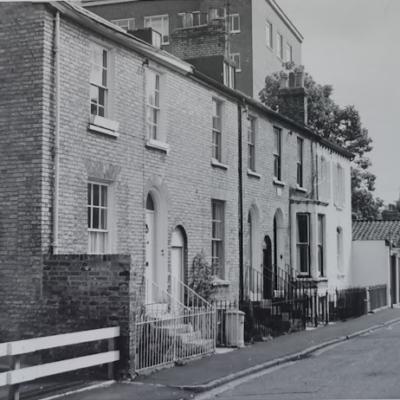Search by topic
- archaeology
- Building of Local Interest
- charity
- church
- crime
- dressmaker
- fire
- Great Eastern Railway
- Listed building
- Mapping Relief
- medieval
- oral history
- poverty
- Public House
- Rattee & Kett
- Religious House
- Roman
- scholar
- school
- Then and Now
- tudor
- women
- work
- world war one
- world war two
Search by text
16 Union Road
History of 16 Union Road
1841 census: [16?]
Rev Bernard Shanly, 38, Catholic Clergyman
‘Catholics in Cambridge’ ed. Nicholas Rogers p.66f, records that Fr Edward Huddleston had been appointed by Bishop Thomas Walsh to establish a new mission in Cambridge. In July 1827 Fr Huddleston took up residence at Sawston Hall, the ancestral home of the Huddleston family.
By January 1828 Fr Huddleston had succeeded in raising about £900 and it appears probable, though opinions seem to differ, that £400 out of this sum was applied to the purchase of a pair of cottages, with land at the rear, in Union Road in the parish of Barnwell (or St Andrew the Less). Although Richard Huddleston was responsible for arranging this purchase, the transaction had to proceed with extreme caution, through a nominee. There was every reason to suppose that a vendor, discovering the true identity of the purchaser, or that the property was intended as the site of a future Catholic chapel, would have withdrawn in hostile indignation.
Nothing much happened though over the next few years. In 1840 the Catholic church in England was reorganised and Cambridge achieved new importance in the hierarchy of districts. Bishop Wareing appointed an Irishman, Fr Bernard Shanley, to take responsibility for establishing a Cambridge Mission.
Bishop Wareing had the site, the funds and the architect [Pugin]; Fr Shanley had the energy, imagination and persuasive fund-raising powers needed to galvanise the local (largely Irish) Catholics into a loyal and effective congregation. For the first time since the Reformation Cambridge had regular Sunday Masses, though starting in somewhat squalid and makeshift premises. Fr Shanley’s first Mass for the catholics of Cambridge was said in an upstairs room in the lodging house of Thomas Patrick Price, general dealer, in Newmarket Road, with a chalice borrowed for the occasion from Richard Huddleston. This venue was not chosen again because the floor threatened to collapse. Next followed sixteen weeks’ occupation of a little hut nearly bursting at the seams, before the pair of cottages on the Union Road frontage to the church site became vacant. One cottage served for a time as the priest’s residence and the other as the chapel for the duration of the building period.
1851 census:
Robert Huddlestone, 26, tea dealer, b Scotland
Mary, 29, b Scotland
John Milligan, lodger, 28, draper, b Scotland
William Brownridge, 24, servant, tea dealer, b Scotland
1861 census:
Mary A Chambers, 60, widow, fundholder, b Norfolk
Mary Annie, 33, daily governess, b Duxford
1901 census:
Edward Plumb Bryant, 45, commercial clerk, b Suffolk
Janet Allen, 39, b Scotland
John Douglas, 11, b Cambridge
Charles H, 10, b Cambridge
Margaret Alice, 10, b Cambridge
Frances Allen, 9, b Cambridge
Janet Elizabeth, 6, b Cambridge
Elizabeth C, 4, b Cambridge
1911 census:
Marion Hart, 64, widow, laundress, b Cambridge
Annie Pratt, 47, daughter, single, assistant in laundry, b Cambridge
Margaret Pratt, 38, daughter, single, assistant in laundry, b Cambridge
1913
Mrs Hart
Contribute
Do you have any information about the people or places in this article? If so, then please let us know using the Contact page or by emailing capturingcambridge@
License
This work is licensed under CC BY-NC-SA 4.0







